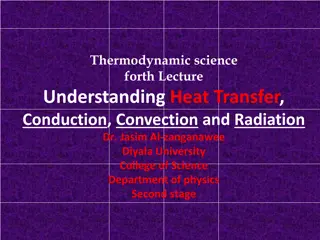Understanding the 8085 Microprocessor Programming Model
The 8085 microprocessor, made by Intel, features general purpose registers, an accumulator, flag register, stack pointer, and program counter. The programming model includes ALU operation, flag flip-flops, and different instruction formats and operand types for executing tasks efficiently.
Download Presentation

Please find below an Image/Link to download the presentation.
The content on the website is provided AS IS for your information and personal use only. It may not be sold, licensed, or shared on other websites without obtaining consent from the author. Download presentation by click this link. If you encounter any issues during the download, it is possible that the publisher has removed the file from their server.
E N D
Presentation Transcript
The 8085 Programming Model Microprocessors & Interfacing 1
The 8085 Microprocessor The 8085 is an 8-bit microprocessor made by Intel. It has: 6 general purpose registers An accumulator Aflag register Astack pointer Aprogram counter Accumulator B D H Flags C E L Program Counter Stack Pointer Microprocessors & Interfacing 2
The 8085 Programming Model The Registers The 6 general purpose registers are 8-bits wide each. They are to be used as needed. They are called B, C, D, E, H, and L. They can be used as 16-bit register pairs: BC, DE, HL. The accumulator is technically part of theALU. It is 8-bits wide. It is one of the inputs to everyALU operation. The result of any operation is always stored in it. It is known as RegisterA. Microprocessors & Interfacing 3
The 8085 Programming Model TheALU includes five flag flip-flops that are set or reset after an operation. They are Z (zero), CY (carry), S (sign), P (parity) andAC (Auxiliary Carry). These flags are used when the microprocessor tests for data conditions. These make up the Flags Register. Microprocessors & Interfacing 4
The 8085 Instructions Since the 8085 is an 8-bit device it can have up to 28(256) instructions. However, the 8085 only uses 246 combinations that represent a total of 74 instructions. Most of the instructions have more than one format. These instructions can be grouped into five different groups: Data Transfer Operations Arithmetic Operations Logic Operations Branch Operations Machine Control Operations Microprocessors & Interfacing 5
Instruction and Data Formats Each instruction has two parts. The first part is the task or operation to be performed. This part is called the opcode (operation code). The second part is the data to be operated on Called the operand . Microprocessors & Interfacing 6
Operand Types There are different ways for specifying the operand: There may not be an operand (implied operand) CMA The operand may be an 8-bit number (immediate data) ADI 4FH The operand may be an internal register (register) SUB B The operand may be a 16-bit address (memory address) LDA 4000H Microprocessors & Interfacing 7
Instruction Size Depending on the operand type, the instruction may have different sizes. It will occupy a different number of memory bytes. Typically, all instructions occupy one byte only. The exception is any instruction that contains immediate data or a memory address. Instructions that include immediate data use two bytes. One for the opcode and the other for the 8-bit data. Instructions that include a memory address occupy three bytes. One for the opcode, and the other two for the 16-bit address. Microprocessors & Interfacing 8
Instruction with Immediate Date Operation: Load an 8-bit number into the accumulator. MVI A, 32 Operation: MVI Operand: The number 32 Binary Code: A 1st 2nd byte. byte. 0011 11103E 0011 001032 Microprocessors & Interfacing 9
Instruction with a MemoryAddress Operation: go to address 2085. Instruction: JMP 2085 Opcode: JMP Operand: 2085 Binary code: 1100 0011 1000 0101 0010 0000 1stbyte. 2nd byte 3rd byte C3 85 20 Note: Error in book on page 146. Microprocessors & Interfacing 10
Addressing Modes The microprocessor has different ways of specifying the data for the instruction. These are called addressing modes . The 8085 has four addressing modes: Implied Immediate Direct Indirect Load the accumulator with the contents of the memory location whose address is stored in the register pair BC). CMA MVI B, 45 LDA4000 LDAX B Microprocessors & Interfacing 11
Data Formats In an 8-bit microprocessor, data can be represented in one of four formats: ASCII BCD Signed Integer Unsigned Integer. It is important to recognize that the microprocessor deals with 0 s and 1 s. It deals with values as strings of bits. It is the job of the user to add a meaning to these strings. Microprocessors & Interfacing 12
Data Formats Assume the accumulator contains the following value: 0100 0001. There are four ways of reading this value: It is an unsigned integer expressed in binary, the equivalent decimal number would be 65. It is a number expressed in BCD (Binary Coded Decimal) format. That would make it, 41. It is anASCII representation of a letter. That would make it the letterA. It is a string of 0 s and 1 s where the 0th and the 6thbits are set to 1 while all other bits are set to 0. ASCII stands forAmerican Standard Code for Information Interchange. Microprocessors & Interfacing 13























